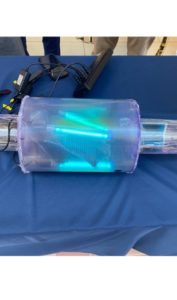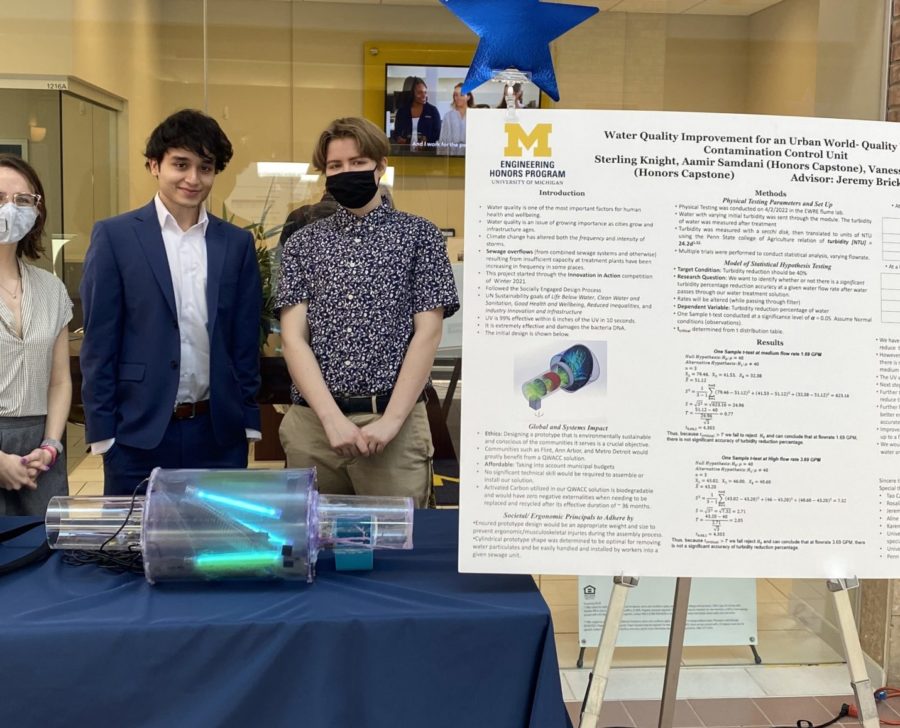Aquaducks: One Year Later
The Aquaducks are overflowing with innovative ideas and positivity since competing in Innovation in Action 2021. Recently, I caught up with co-founder Vanessa Woolley almost a year after I first learned about the Aquaducks’ Quality Water & Contamination Control device (QWACC) aimed to treat wastewater and overflows.
Story by Malin Andersson
Prepare yourself for stream-of-consciousness water puns flowing your way.
Since we last spoke, the Aquaducks have made a splash by adding on two new team members: Junior in Environmental Engineering Sterling Knight and Senior in Industrial Engineering Aamir Samdani. Aquaducks co-founders Rosalia Otaduy and Tao Cai have had to focus on their academic obligations, but Knight and Samdani have made great additions to the team as they sail on from iteration to prototyping.
Currently, the Aquaducks are working with a Fellowship through the Center for Socially Engaged Design to continue creating their prototype. Though finding and ordering materials has been particularly challenging due to shipping difficulties, the Aquaducks have learned to be flexible and creative.
With the time and resources provided by C-SED, Vanessa told me about all the (water)ways in which they’ve been given the room to expand and grow.
Since Innovation Salon a year ago, how has your process shifted and expanded?
Going from the ideation phase to the testing phase is a huge step – way bigger than I thought it was going to be. A lot of the prototyping process is just realizing “man, this really is hard.” We considered detailed specifications while always asking, how can we make this all come together and pitch it as a feasible solution to this huge problem?
I’m always thinking about that pitch for Innovation in Action: “How would I market this solution if I was going to a wastewater treatment plant tomorrow? How am I talking about this to my friends or when people ask me what I am doing this semester?” It’s all about advocating for what I’ve worked so hard on.
How did you come up with the plan for creating the prototype?
It’s all about making it work with what you have. It’s easy to get something custom-made but that’s like a million dollars, so we’ve been focusing on staying within a budget to make a working prototype. Then, we can move on to making it fancy.
Making it work looks like moving the chairs out of my living room and using painter’s tape to scale the prototype of the filter. It’s googling backups in case our 8-inch pipe doesn’t work or calling my dad who works in construction to figure out where to find material. Through all of it, we’re still making it work.

The Quality Water & Contamination Control device (QWACC) prototype
Was there a guiding question during this first phase of prototyping?
We were guided by two questions: How well do these filters reduce turbidity and what is the head loss on these filters? (Once you put the water through, how much resistance will the filter give?)
Even when we were doing the prototype originally, we recognized the heavy financial burden of treating water, so we wanted to make something affordable for municipalities that are already strapped for cash. There is a large discrepancy between the federal funding that made the water treatment systems and the municipal funding that maintains these systems. It’s currently a huge problem in wastewater and drinking water treatment.
Who have you connected with during this process? How has your network expanded?
Dr. Jeremy Bricker, my honors and capstone advisor for this project has been very helpful when talking through ideas. As someone with experience in the industry, he is able to help us optimize by saying, “that’s a great idea but what if you did it this way?”
With the help of Jeremy Bricker and Aline Cotel, we’re able to use the Environment and Water Resources (EWRE) lab. Additionally, Aline Cotel suggested I reach out to Dr. Karen Alofs with the School for Environment and Sustainability who has been very kind to lend me her Secchi disk which measures the transparency of water.
People in any department have shown such generosity. Some people are scared to send that first email, but almost 90% of the time you get an email back that is positive and connects you to someone who can help. That’s the Michigan community that’s always talked about when you’re getting recruited to come here. Some people are scared to send that first email, but almost 90% of the time you get an email back that is almost always positive and connects you to someone who can help.


